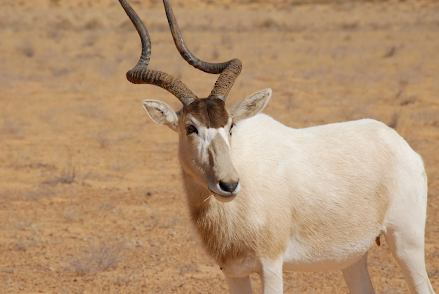Endangered Species: Addax
The IUCN Red List has classified addaxes as Critically Endangered(CR), with only 30-90 addaxes left in the wild, a number which continues to decrease. According to Animalia, these majestic mammals can weigh as much as 60-125 kg (132-375 lbs), can grow as tall as 95-115 cm (37-45 in), and get as long as 120-130 cm (47-51 in). Their fur is beige/white in the summer and darkens in the winter, which helps maintain a healthy body temperature. Animaldiversity.org states that both males and females have horns, with the length averaging 72 cm. To travel better in their sandy, stony habitat, their hooves are splayed. These antelopes generally live 19 years in the wild and 25 years in captivity.
 |
| An addax gazes at the desert. Source: Animals Wiki |
Domain: Eukarya
Kingdom: Animalia
Subkingdom: Bilateria
Infrakingdom: Deuterostomia
Phylum: Chordata
Subphylum: Vertebrata
Infraphylum: Gnathostomata
Superclass: Tetrapoda
Class: Mammalia
Subclass: Theria
Infraclass: Eutheria
Order: Artiodactyla
Family: Bovidae
Subfamily: Hippotraginae
Genus: Addax
Species: nasomaculatus
Addaxes inhabit Northern Africa, with their shrinking range including parts of Chad, Niger, and possibly Mauritania. According to the IUCN Red List, their range used to also take up Algeria, Egypt, Libya, Morocco, Sudan, Tunisia, and Western Sahara. They live in regions of arid deserts, some of which receive less than 100 mm of rainfall per year. These folivores feed on desert grasses and scrubs such as tussock grasses and succulent thorn scrub cornulaca, as well as herbs and species of acacia. Because their Sahara habitat has sparse vegetation, they often roam large areas in search of food. However, they do not search for water. Because they get the moisture they need from the plants they eat, an addax can go almost its entire life without drinking water. Addaxes move in herds of 5-20, during the night, with a dominant male in the lead. Males are territorial, and females establish a hierarchical system. During the hottest parts of the day, they will often dig "beds" under shade to keep cool and safe.
An addax herd takes a rest in the shade.
Source: Natural Resources Defense Council (NRDC)
Their are many factors that caused the steep decrease in the Addax's population. According to Animalia, the meat and skin of the Addax is valued by locals, and these slow, bulky antelopes are easy to kill for humans with modern weapons. Farming and livestock ranching by growing local communities are eating away at the Addax's available habitat. Local populations have also used poor farming and soil management practices, leading to desertification of the land and the small amount of vegetation the Addax depends on to survive. The effects of desertification are amplified by the recent droughts in the area that are caused by climate change and global warming. In addition to local populations, tourists often follow and chase these animals in vehicles adapted to travelling in the desert, leading the animals to exhaustion and death. They are also endangered by oil and gas drilling.
An addax grazes in its arid habitat.
Source: International Union for Conservation of Nature (IUCN)
Organizations are rushing to preserve what is left of the Addax population. In 2012, with the help of lobbying by the Sahara Conservation Fund, the Termit and Tin Touma Reserve was established. The Reserve encompasses much of the land that the remaining Addaxes inhabit. Despite these efforts, conservationists worry that climate change will lead the Addax's range to shift to cooler areas as the entire planet continues to warm. A shift would decrease the impact of reserves and parks like Termit and Tin Toumma. Efforts have also been made by organizations and local populations to mitigate poaching. Researchers continue to monitor the species in hopes of protecting the individuals remaining.
You can show your support for Addaxes by donating to the following charities:
- Sahara Conservation Fund
- Natural Resources Defense Council (NRDC)
- International Union for Conservation of Nature (IUCN)
- Saint Louis Zoo
- Louisville Zoo

